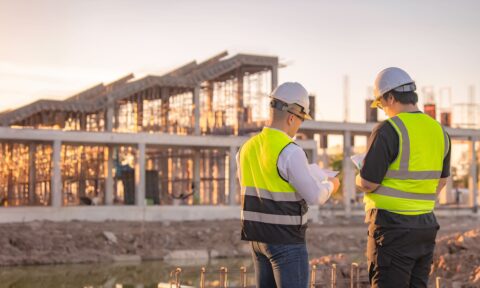Ship Structures: Strength, Fabrication and Distortion Control
- Course covers practical aspects of hull girder fabrication, welding methods, structural response, ship design principles, and regulations. Engineers, scientists, shipbuilders, and ship management personnel benefit from the course's innovative content and structure. Lectures focus on structural components, material, fabrication, strength analysis, welding technology, ship structure reliability, and distortion control techniques. Ultimate strength analysis of ship hull girders and compliance with International Association of Classification Society regulations are key components of the course.
Overview
This course focuses on the practical aspects of hull girder fabrication, structural response, and strength of ship components. It covers welding methods, accuracy control, and the ultimate strength analysis of ship structural components. Engineers, scientists, ship management personnel, and shipbuilders will benefit from the innovative content and balanced theory-practice approach. Lectures include topics such as structural components, material and fabrication, structural strength, beam columns, welding technology, ship structure reliability, and distortion control. Regulations from the International Association of Classification Society are also discussed.
Who should attend
Engineers, Scientists, Shipbuilders, Ship Management Personnel
Course Content
About the Course
The syllabus will include: practical aspects of hull girder fabrication, such as sequence of welding, advanced welding methods and its advantages, accuracy control, etc, structural response of the hull girder, strength of ship structural components such as beams, columns, plates including the effect of initial imperfections such distortion due to welding & residual stresses. The course will also introduce the basic structural design of ships from the first principle including the ultimate strength analysis of structural components like stiffened plates which forms 80% of structural components of a ship shull girder. Ultimate strength analysis of ship hull girders will be done. A brief introduction of various regulations imposed by International Association of Classification Society (IACS) will also be reviewed, including common structural rule (CSR).
Who Should Attend
Engineers and scientists involved in the design of ships and ship systems. Personnel from ship management companies, oil companies, classification societies and ship builders will benefits from attending this course. The course is innovative in both content & structure with a careful balance of theory & practice.
Content of the Lectures
Lecture 1: Structural Components, Subassemblies and Assemblies
The various structural components are prefabricated and they are subsequently aligned and welded in position. These are essentially two dimensional or simple three dimensional structures, comprised of flat or curved stiffened panels. These flat or curved stiffened panels would be either longitudinally framed or transversely framed.
Lecture 2: Material and Fabrication
Various grades of steels, marine grade aluminum alloys and glass fibre reinforced plastics as materials for ship construction are used. Fabrication activity is preceded by material preparation. Plate cutting with accepted dimensional accuracy is required. Subsequent plate and section forming is carried out either by mechanical means or through line heating technique.
Lecture 3: Structural Strength: Longitudinal, Transverse & Local Strength
Distribution of weight and buoyancy,still water bending moment,wave induced bending moment,bending and shear stress.
Lecture 4: Beam Columns
Elastic buckling, in elastic Buckling, Johnson’s formula, Perry Robertson Formula, Column Curves, DNV Codes.
Lecture 5: Structural Response of Stiffened Plate – I
Standards and guidelines; Stiffened plated structure Buckling & post buckling of unstiffened plates, Ultimate strength of stiffened plate, com-bined loading under axial & lateral load, Design codes API RP 2V, DNV- RPC201, Example problems.
Lecture 6: Structural Response of Stiffened Plate – II
Standards and guidelines; Stiffened plated structure Buckling & post buckling of unstiffened plates, Ultimate strength of stiffened plate, com-bined loading under axial & lateral load, Design codes API RP 2V, DNV- RPC201, Example problems
Lecture 7: Welding Technology – I
Welding power source and metal transfer mechanism; Effect of welding parameters on weld deposition and bead profile;
Lecture 8: Welding Technology – II
Various welding methods suitable for shipbuilding including electros slag and electro gas welding process; Solid state welding that produce sound joints at temperatures much below the parent metal
melting temperature.
Lecture 9: Ship Structure Reliability
Uncertainties in loads and strength, Combination of uncertanties. Linear error theory, Advanced first
order second moment method,Safety index, Probability of failures.
Lecture 10: Ultimate Strength of Hull Girders
Progressive collapse analysis of hull girder, load shortening curves Smith’s method.
Lecture 11: Distortion Control I The panels, subassemblies and assemblies being welded are subjected to thermal cycles of heating followed by cooling. As the weld metal and the base metal cool down to the room temperature residual stresses and shrinkage forces develop. These stresses and forces result into various types of weld induced structural distortion.
Lecture 12: Distortion Control II
Distortion control needs to start from implementation of appropriate design and fabrication techniques. Distortion mitigation can be done through heat sinking. Mitigation of buckling
distortion of stiffened panels can be done by applying an active distortion mitigation technique known as Thermo-Mechanical Tensioning (TMT).



